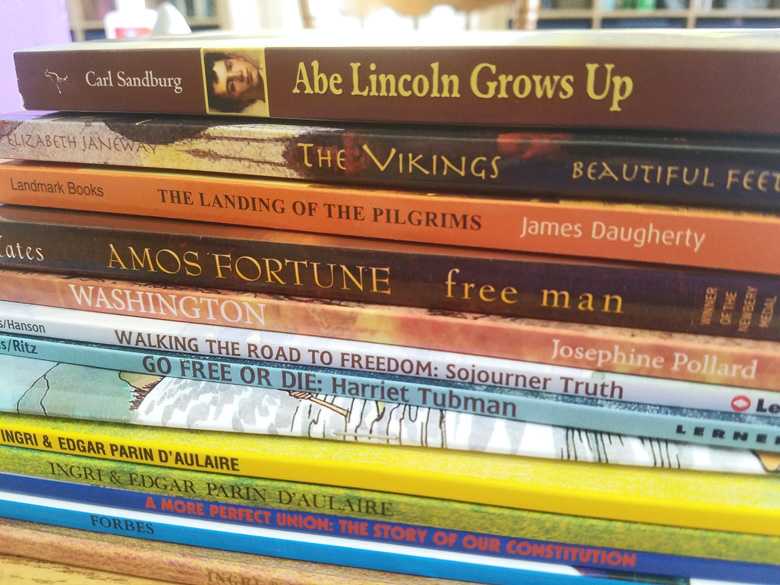How to Make History Meaningful with Living Books
Ditch those boring history textbooks and give your kids fascinating, high-quality living books that make history come alive!
Think back to your elementary history classes for a moment. What do you remember?
If you’re like me, you probably don’t remember much at all. And no wonder. Dry textbooks and boring lists of facts don’t do much do create a love of history.
I want better than that for my kids. I want them to genuinely LOVE history and KNOW the people who lived that history.
So instead of handing my kids a dry history textbook, I’m giving them fascinating, high-quality living books that make history meaningful to them.
This post is sponsored by Beautiful Feet Books. I was compensated for my time writing this post. See my Disclosure Policy for more information.
What Are Living Books?
The term “living books” was originally coined by Charlotte Mason, a British educator in the late 1800s and early 1900s. Miss Mason encouraged the use of rich, engaging literature instead of dry textbooks or watered-down books for learning.
In a nutshell, living history books are high-interest books written by an author whose genuine love and understanding of history shines through.
Whether fiction or non-fiction, these books are written in an engaging narrative or story form that captures the imagination of the reader and makes the subject come alive.
Instead of just listing dry facts, living books pull readers deeply into the subject and involve their emotions, helping them build a personal connection with people and events of the past.
Why Living Books are the Best Way to Teach History
Living books provide a deeper understanding of history.
Living books allow for much deeper coverage of history. Individual topics are not limited to just a couple paragraphs, or maybe a page or two, as they would be in a history textbook.
Instead students can read an entire book on a specific topic, gaining more context and learning more about people, places, and events in a natural way.
Living books show the personal side of history.
Living books focus primarily on personal stories. Readers see history happening through the eyes of one individual, and then follow the story as it moves outward.
This personal connection is the key to bringing history to life. Kids can feel the emotions, face the fears, and celebrate the accomplishments along with the characters in the book.
Living books connect stories to the big picture of history.
Even though the focus of living books is on personal stories, these stories aren’t isolated. Rather, real-life stories are interconnected to create the big picture that we call history.
To put it another way, living books are the flesh that we put on the skeleton of historical facts. The bare bones of dates and events are made interesting and relatable when they are fleshed out with real-life stories.
Living books encourage a natural way of learning.
Unlike textbooks that follow a predetermined sequence, living books encourage learning based on a child’s natural interest. If a student is deeply interested in a particular person or event, they can read as many different living books as they like on that topic.
On the other hand, if a child stumbles across a new topic of interest, they are free to dive into it without waiting until an artificial scope and sequence allows them to move on.
This post contains affiliate links. If you click on an affiliate link and make a purchase, we will receive a small commission. See our Disclosure Policy for more information.
Easy-to-Use Living Literature Curriculum
A few weeks ago we were excited to get the Early American History Intermediate Jumbo Pack, an excellent literature curriculum from Beautiful Feet Books.
I had drooled over Beautiful Feet Books for YEARS, but never took the plunge until now. And oh, my! This literature curriculum is every bit as wonderful as I dreamed it would be!
My 9-year-old daughter, who is an avid reader, is absolutely thrilled with her new American history books. In fact, I wouldn’t be surprised if she has the entire set completed before summer is over!
The Early American History Intermediate Jumbo Pack includes:
- Teacher Guide
- 15 living books
- Timeline
- 4 Your Story Hour CDs
- Blank composition notebook
The Teacher Guide is straightforward and easy to use. In fact, each day’s lesson is covered in less than half a page in the Teacher Guide. Yes, really!!
The living books are beyond wonderful. These aren’t watered-down children’s story books, but real, engaging books that even adults would enjoy reading.
Daily reading assignments are listed in the Teacher Guide, followed by a few oral review questions or another easy-to-manage learning activity.
No busywork, no intense projects, no frustration or tears. Just real learning through engaging books that the whole family will love!
Get it here: Early American History Intermediate Jumbo Pack







